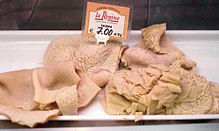
Tripe is a type of edible lining from the stomachs of various farm animals. Most tripe is from cattle, pigs and sheep. [1] [2]

Tripe is a type of edible lining from the stomachs of various farm animals. Most tripe is from cattle, pigs and sheep. [1] [2]
Beef tripe is made from the muscle wall (the interior mucosal lining is removed) of a cow's stomach chambers: the rumen (blanket/flat/smooth tripe), the reticulum (honeycomb and pocket tripe), and the omasum (book/bible/leaf tripe). Abomasum (reed) tripe is seen less frequently, owing to its glandular tissue content.
Tripe refers to cow (beef) stomach, but includes stomach of any ruminant including cattle, sheep, deer, antelope, goat, ox, giraffes, and their relatives. Tripas, the related Spanish word, also refers to culinary dishes produced from the stomach of an animal. In some cases, other names have been applied to the tripe of other animals. For example, tripe from pigs may be referred to as paunch, pig bag, or hog maw .
| Nutritional value per 100 g (3.5 oz) | |
|---|---|
| Energy | 355 kJ (85 kcal) |
0 g | |
| Sugars | 0 g 0 g |
| Dietary fibre | 0 g |
3.69 g | |
| Saturated | 1.291 g |
| Monounsaturated | 1.533 g |
| Polyunsaturated | 0.180 g |
12.07 g | |
| Vitamins | Quantity %DV† |
| Vitamin A equiv. | 0% 0 μg |
| Thiamine (B1) | 0% 0 mg |
| Riboflavin (B2) | 5% 0.064 mg |
| Niacin (B3) | 6% 0.881 mg |
| Pantothenic acid (B5) | 2% 0.1 mg |
| Vitamin B6 | 1% 0.014 mg |
| Folate (B9) | 1% 5 μg |
| Vitamin B12 | 58% 1.39 μg |
| Vitamin C | 0% 0 mg |
| Vitamin D | 0% 0 μg |
| Vitamin E | 1% 0.09 mg |
| Vitamin K | 0% 0 μg |
| Minerals | Quantity %DV† |
| Calcium | 7% 69 mg |
| Iron | 5% 0.59 mg |
| Magnesium | 4% 13 mg |
| Manganese | 4% 0.085 mg |
| Phosphorus | 9% 64 mg |
| Potassium | 2% 67 mg |
| Sodium | 6% 97 mg |
| Zinc | 15% 1.42 mg |
| Other constituents | Quantity |
| Water | 84.16 g |
| |
| †Percentages are roughly approximated using US recommendations for adults. Source: USDA FoodData Central | |
Washed tripe is more typically known as dressed tripe. To dress the tripe, the stomachs are cleaned and the fat trimmed off. [3] It is then boiled and bleached, giving it the white color more commonly associated with tripe as seen on market stalls and in butchers' shops. The task of dressing the tripe is usually carried out by a professional tripe dresser.
Dressed tripe was a popular, nutritious and cheap dish for the British working classes from Victorian times until the latter half of the 20th century. [4] [5] [6] While it is still popular in many parts of the world today, the number of tripe eaters, and consequently the number of tripe dressers, in the UK has rapidly declined. Tripe has come to be regarded as a pet food, as the increased affluence of postwar Britain has reduced the appeal of this once staple food.
It remains a popular dish in many parts of continental Europe such as Portugal, Spain, France and Italy. In France, a very popular dish, sold in most supermarkets, is tripes à la mode de Caen . In Spain callos a la madrileña are served as tapas in many restaurants as well as in supermarkets. The most beloved and celebrated dish in the city of Porto and surrounding areas, in Portugal, is 'tripas à moda do Porto', a tripe stew made with white butter beans, carrots, paprika and chouriço. It is so loved that locals are called 'Tripeiros', in an homage to the 'tripa' (tripe).
Tripe is eaten in many parts of the world. Tripe soup is made in many varieties in the Eastern European cuisine. Tripe dishes include:


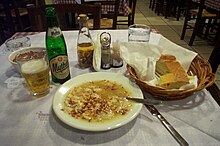


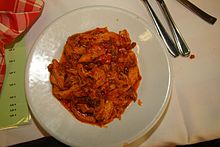
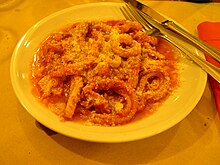
In Spanish- and Portuguese-speaking countries, the close cognate tripas tends to denote small intestines rather than stomach lining. Dishes of this sort include:
Another type of food made from the small intestines are chitterlings (chitlins).
Beef tripe is also a common meat in Kerala, India. Beef tripe and tapioca (kolliyum bottiyum) is a traditional wedding eve dinner for Christians in some parts of Kerala.
The Tripe Marketing Board promotes World Tripe Day on 24 October, because on that day in 1662, Samuel Pepys wrote, "So home and dined there with my wife upon a most excellent dish of tripes of my own directing." [9]

Turkish cuisine is the cuisine of Turkey and the Turkish diaspora. Although the cuisine took its current rich form after numerous cultural interactions throughout centuries, it should not be confused with other cuisines such as Ottoman cuisine or Seljuk cuisine. Turkish cuisine with traditional Turkic elements such as yogurt, ayran, kaymak, exerts and gains influences to and from Mediterranean, Balkan, Middle Eastern, Central Asian and Eastern European cuisines.

Offal, also called variety meats, pluck or organ meats, is the internal organs of a butchered animal. The word does not refer to a particular list of edible organs, and these lists of organs vary with culture and region, but usually exclude skeletal muscle. Offal may also refer to the by-products of milled grains, such as corn or wheat.
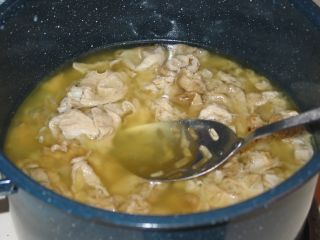
Chitterlings, sometimes spelled chitlins or chittlins, are the small intestines of domestic animals. They are usually made from pigs' intestines. They may also be filled with a forcemeat to make sausage. Intestine from other animals, such as beef, lamb, goose, and goat is also used for making chitterling.
Romanian cuisine is a diverse blend of different dishes from several traditions with which it has come into contact, but it also maintains its own character. It has been mainly influenced by Turkish and a series of European cuisines in particular from the Balkans, or Hungarian cuisine as well as culinary elements stemming from the cuisines of Central Europe.

Peasant foods are dishes eaten by peasants, made from accessible and inexpensive ingredients.

Tripe soup or tripe stew is a soup or stew made with tripe. It is widely considered to be a hangover remedy.
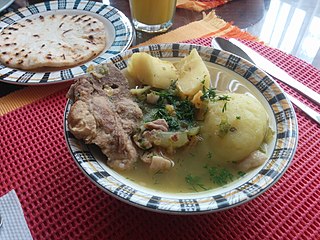
Sancocho is a traditional stew in Canarian cuisine and several Latin American cuisines. Latin variations represent popular national dishes in Dominican Republic, Colombia, Cuba, Honduras, Mexico, Ecuador, Panama, Puerto Rico, Trinidad and Tobago, and Venezuela. It usually consists of large pieces of meat, tubers and vegetables served in a broth.

Noodle soup refers to a variety of soups with noodles and other ingredients served in a light broth. Noodle soup is a common dish across East Asia, Southeast Asia and the Himalayan states of South Asia. Various types of noodles are used, such as rice noodles, wheat noodles and egg noodles.

Sopa de mondongo is a soup made from diced tripe slow-cooked with vegetables such as bell peppers, onions, carrots, cabbage, celery, tomatoes, cilantro, garlic or root vegetables. The dish is generally prepared in former Spanish colonies in Latin America, Caribbean, and in the Philippines.

Gopchang (Korean: 곱창) is a dish in Korean cuisine. It can refer to either the small intestines of cattle, the large intestines of pig, or to a gui made of the small intestines. The latter is also called gopchang-gui. The tube-shaped offal is chewy with rich elastic fibers.

Nigerian cuisine consists of dishes or food items from the hundreds of Native African ethnic groups that comprise Nigeria. Like other West African cuisines, it uses spices and herbs with palm or groundnut oil to create deeply flavored sauces and soups.

Javanese cuisine is the cuisine of Javanese people, a major ethnic group in Indonesia, more precisely the province of Central Java, Yogyakarta and East Java.

Tunisian cuisine, the cuisine of Tunisia, consists of the cooking traditions, ingredients, recipes and techniques developed in Tunisia since antiquity. It is mainly a blend of Mediterranean and native Punics-Berber cuisine. Historically, Tunisian cuisine witnessed influence and exchanges with many cultures and nations like Italians, Andalusians, French and Arabs.

Padang dish or Minangkabau dish is the cuisine of the Minangkabau people of West Sumatra, Indonesia. It is among the most popular cuisines in Maritime Southeast Asia. It is known across Indonesia as Masakan Padang after Padang, the capital city of Western Sumatra province. It is served in restaurants mostly owned by perantauan (migrating) Minangkabau people in Indonesian cities. Padang food is ubiquitous in Indonesian cities and is popular in neighboring Malaysia and Singapore.

Gopchang-jeongol (곱창전골) or beef tripe hot pot is a spicy Korean stew or casserole made by boiling beef tripe, vegetables, and seasonings in beef broth. Gopchang refers to beef small intestines, while jeongol refers to a category of stew or casserole in Korean cuisine. Although the dish is mainly based on beef gopchang, other parts of beef innards are also used to give the dish a richer flavor and chewy texture.

A meatball is ground meat (mince) rolled into a ball, sometimes along with other ingredients, such as bread crumbs, minced onion, eggs, butter, and seasoning. Meatballs are cooked by frying, baking, steaming, or braising in sauce. There are many types of meatballs using different types of meats and spices. The term is sometimes extended to meatless versions based on vegetables or fish; the latter are also commonly known as fish balls.

Soto is a traditional Indonesian soup mainly composed of broth, meat, and vegetables. Many traditional soups are called soto, whereas foreign and Western influenced soups are called sop.

Indonesian noodles are a significant aspect of Indonesian cuisine which is itself very diverse. Indonesian cuisine recognizes many types of noodles, with each region of the country often developing its own distinct recipes.